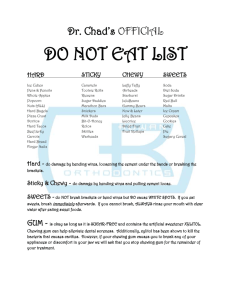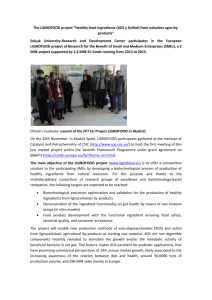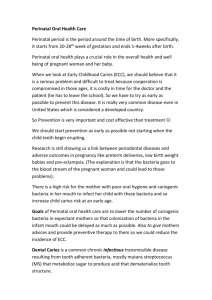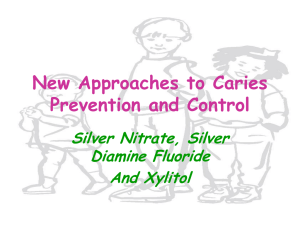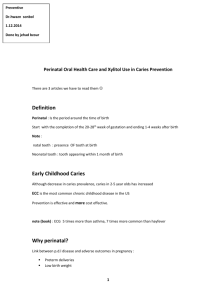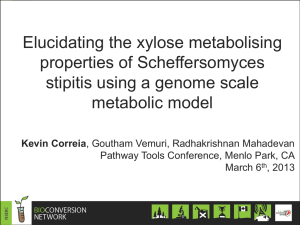Document 10974240
advertisement
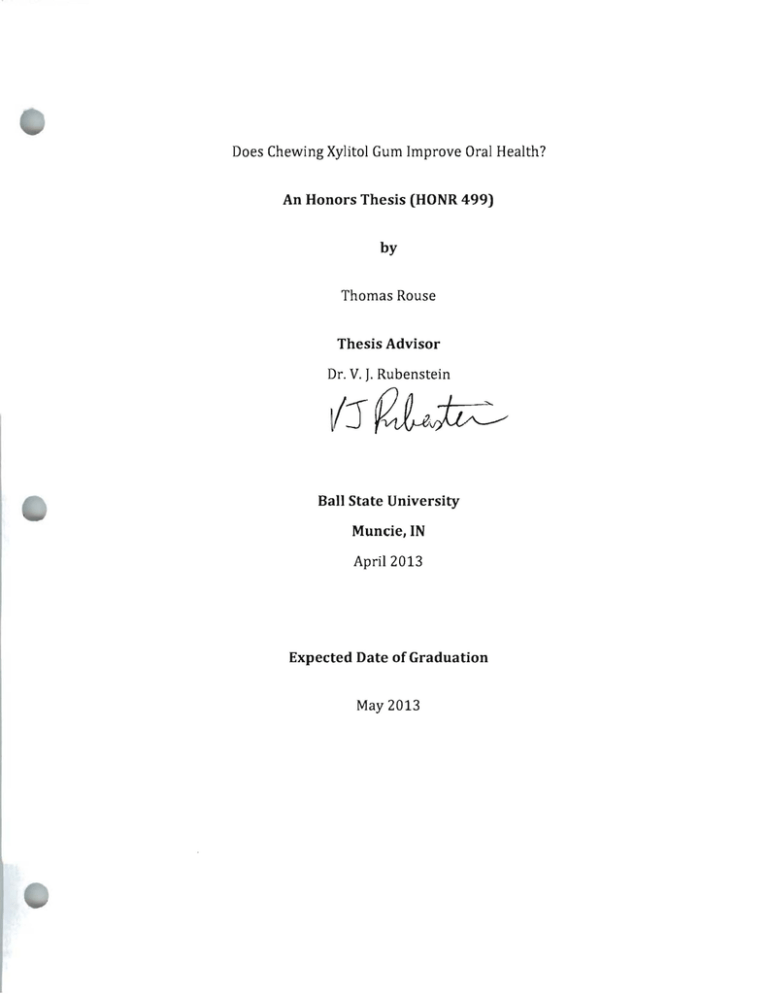
Does Chewing Xylitol Gum Improve Oral Health? An Honors Thesis (HONR 499) by Thomas Rouse Thesis Advisor Dr. V. J. Rubenstein vl~~ Ball State University Muncie, IN April 2013 Expected Date of Graduation May 2013 Epe o }} Under9rvd -rhes/S /....D Abstract C).. 'I B9 ,zs; :;;"013 · RG~ Popular chewing gum brands such as Orbit and Trident advertise that chewing their gum promotes oral health due to the presence ofxylitol. This compound has interested oral health researchers since the 1970 s, but recent advances in research have been used to market it to the public as a prophylactic. Xylitol is a sugar that cannot be fermented by virtually any bacterial species, including Streptococcus mutans (S. mutans), the main contributor to dental caries (tooth cavities). The sugar alcohol negatively affects the pathogen in two different ways: it decreases plaque adhesiveness and inhibits growth. I have analyzed experiments from leading oral health researchers that aimed to determine how xylitol affects S. mutans, the optimal dose ofxylitol for S. mutans inhibition, shortterm and long-term benefits of xylitol, and limitations of xylitol being sold to different socioeconomic classes. While legitimate platforms for xylitol distribution still need to be expanded, the benefits ofxylitol are literally worth salivating over. As governments look to improve health care practices for their citizens, xylitol products should be considered as a legitimate means of reducing oral health maladies. Acknowledgements I would like to thank Dr. V. J. Rubenstein for advising me though the project. His knowledge of microbiology and his experience of analyzing scientific articles made this project possible. I would like to thank my parents, Drs. Tom and Mary Rouse, who have always supported my dream of becoming a dentist. Their words of wisdom and encouragement have pushed me to strive for excellence no matter the task, including this thesis. I would like to thank Dr. Daniel C. Reno, Dr. Thomas R. Clark, and Dr. Kenneth J. Patterson, who were all instrumental in my undergraduate dental education. These dentists helped cultivate the idea for this thesis. 1 Popular chewing gum brands such as Orbit and Trident advertise that chewing their gum promotes oral health due to the presence of xyli to I. This compound has interested oral health researchers since the 1970's, but recent advances in research have been used to market it to the public as a prophylactic (Soderling 2009b). Xylitol is a sugar that cannot be fermented by virtually any bacterial species, including Streptococcus mutans (5. mutans), the main contributor to dental caries (tooth cavities). Ingesting specific concentrations ofxylitol reduces 5. mutans colonization and decreases plaque build-up. Fewer dental caries directly translates to improved oral health and indirectly means less money spent on dental procedures. While products such as Orbit gum and Trident gum do in fact contain xylitol, a consumer would have to chew roughly twenty pieces of gum to reap the benefits. Oral health researchers and product developers now have the challenge of making xylitol products that effectively inhibit 5. mutans and are accessible to various socioeconomic classes. In order to understand how 5. mutans affects teeth, it is important to understand tooth anatomy. Teeth are composed of four different types of tissues, with three of the four tissues being hard. The innermost soft tissue is the pulp, which is composed of nerves and blood vessels that supply nutrients to the tooth (Hammarstrom 1997). As long as the pulp remains coated, aches and pain are not an issue; however, when the outer three hard layers are compromised, air, liquid, and bacterial pathogens can infiltrate, causing significant discomfort. Covering the pulp is a layer called the cementum. This layer begins the hard portion of the tooth and extends down into the roots. The second hard layer is known as dentin. Dentin 2 is chiefly responsible for filling most of the inner portion of the tooth, while enamel covers the outside of the tooth (Kinney et. 2003). Enamel, the visible portion of the tooth, enhances chewing strength. Although the three hard layers are extremely dense, they are susceptible to corrosion and can be compromised. Tooth tissue is formed by cell multiplication. The hard layers are primarily composed of the minerals calcium and phosphate (Loesche 1996). These minerals combine to form an enamel network that is stronger than concrete. However, once the enamel is degraded by bacterial metabolic byproducts (demineralization) it cannot regenerate (Kinney et. al 2003). Thankfully, the oral cavity has developed measures to neutralize the acids and metabolic bacterial byproducts in the process of remineralization (Loesche 1996). Saliva distributes calcium and phosphates to demineralized sites naturally, but remineralization can only partially compensate for enamel loss (Hammarstrom 1997). Prolonged exposure to acidic conditions leads to plaque, a destructive biofilm that hardens and initiates enamel destruction. Acidic conditions in the mouth limit saliva's effectiveness in maintaining an aerobic environment because less saliva is produced by the parotid glands; less saliva causes the mouth to shift to an anaerobic environment (Caglar et al. 2007). This is detrimental to oral health because S. mutans thrive in anaerobic conditions. Under these conditions, demineralization occurs faster than restorative remineralization efforts, reSUlting in tooth decay (Hayes 2001). Initially, caries (cavities) can develop, but far more serious maladies 3 such as toothache, infection, and tooth loss can result. Additionally, gum inflammation and gum disease are common in oral cavities that are losing the mineralization battle (Loesche 1996). Individuals most susceptible to tooth decay are those who over-consume sugary and starchy foods, sodas, and those taking medications where dry mouth is a side effect (Soderling 2009a). Because natural means to remineralize tooth surfaces are often overwhelmed by sugars and bacterial acids, artificial means are used to increase remineralization efforts. These methods include sugarless gum chewing, fluoride treatment, and casein phosphopeptides-amorphous calcium phosphate toothpaste, or CPP-ACP, toothpaste (Loesche 1996). Chewing sugarless gum after eating exercises jaw muscles and promotes salivation. This accelerates the processes of rinsing away acid and uptake of beneficial calcium phosphate molecules to remineralize tooth enamel. The recommended length of time for chewing after eating is approximately twenty minutes (Hayes 2001). Unlike habitual daily use of chewing gum, topical fluoride is applied only in a dentist's office. The naturally occurring mineral fluoride reinforces enamel strength against demineralization and increases remineralization. While fluoride use is hotly debated among a minority of organizations such as the Fluoride Action Network, the American Dental Association fully supports fluoride use to encourage healthy tooth and gums (American Dental Association 2013). The United States government adds fluoride to the drinking water of more than 72% of communities to reach the optimal levels of 0.7 ppm (National Cancer Institute 2013). Of particular interest concerning fluoride consumption is the fact that expectant mothers who incorporate fluoride into their 4 diet (for example, through treated tap water) transmit calcium fluoride to their children. Fluoride opponents argue that fluorination of water limits freedom of choice and causes cancer; however, the National Cancer Institute research has found no link between cancer and fluoride (National Cancer Institute 2013). Additionally, the Centers for Disease Control considers fluorinated water one of the greatest achievements in public health in the 20th century (CDC 2013). Fluoride can cross placental barriers and reinforce enamel stability in developing fetuses. CPP-ACP toothpaste is partially composed of proteins found in milk; it penetrates and fortifies the enamel during remineralization. CPP-ACP toothpaste aids in transporting calcium phosphates to corroding teeth during remineralization (Loesche 1996). While fluoride and CPP-ACP toothpaste are certainly used in isolation of one another, they are commonly found in combination in toothpastes, material for caries fillings, and oral mouthwashes. Natural and artificial remineralization efforts are often insufficient to compensate for lifestyle choices that promote growth of bacteria (particularly s. mutans, the bacterium primarily credited with caries development) and acid production. It is crucial to establish hygiene habits early in life to prevent oral S. mutans colonization (Soderling 2009b). Lifestyle habits that are destructive to remineralization are also the lifestyle habits that enable S. mutans to thoroughly colonize the oral cavity. These include consuming sizable amounts of sugary substances, drinking soda, eating sticky teeth­ hugging candy and fruits, and ingesting medications that cause dry mouth (Milgram 2006). Additionally, snacking throughout the day provides more time for S. mutans to colonize on tooth enamel and less time for salivary remineralization. Medications 5 causing dry mouth are often unavoidable and likely serve a higher purpose that justifies interfering with oral hygiene; however, it should be noted that a dry mouth deprives the mouth of saliva necessary to oppose S. mutans colonization around tooth and gum surfaces (Holgerson 2006). A dry environment leaves the enamel and dentin tooth layers little chance against the persistent S. mutans. According to Bergey's Manual of Systematic Bacteriology, S. mutans are paired, non-motile, non-capsulated Gram-positive cocci, approximately 0.5 micrometers in diameter (Boone 2001). S. mutans have evolved to become experts , in biofilm (plaque) formation in the oral cavity. S. mutans form colonies on tooth enamel and synthesize insoluble polysaccharides from sucrose provided by host food intake. These insoluble polysaccharides enable S. mutans to adhere to tooth enamel and form biofilms. Plaque creates an impenetrable barrier to saliva, allowing the acidic metabolic byproducts of S. mutans to perSist in a concentrated form next to teeth. The byproducts corrode enamel, unchecked by remineralization efforts and create dental caries (Sano et al. 2007). The most detrimental aspect of S. mutans occurs as these bacteria ferment sucrose, producing lactic acid as a byproduct (Loesche 1996). Unlike other bacteria of the oral flora, S. mutans is not only cariogenic, but also possesses enzymes that allow the cells to tolerate the harsh acidic conditions generated by lactic acid fermentation. Furthermore, S. mutans has elevated amounts of ATPase proton pumps, the enzyme responsible for exporting protons from the cell (Loesche 1996). 'Elevated levels of ATPase proton pumps allow S. mutans to survive in a low pH environment, outcompete other oral cavity bacteria, continue to form lactic acid, and maintain internal homeostasis. (Lemos et 6 aI2005). Lactic acid is particularly corrosive because it chelates (sequesters) calcium phosphate (which would otherwise promote remineralization) from enamel faster than saliva can replace it (Loesche 1996). Given that S. mutans poses such a threat to oral health, it is understandable that the dental community would attempt to control this pesky bacterium. Thus far, the most effective method for inhibiting S. mutans colonization and acid production has been exposure to xylitol. As a natural non-cariogenic sweetener, xylitol has gained popularity for inhibiting growth of S. mutans. The sugar alcohol negatively affects the pathogen in two different ways: it decreases plaque adhesiveness and inhibits growth (Soderling 2009b). With fewer polysaccharides to attach to tooth enamel, plaque biofilms cannot attach as frequently or as robustly. Additionally, xylitol reduces plaque acidogenicity. With plaque pH raised to healthier levels, salivary enzymes and calcium phosphates can facilitate remineralization faster than the plaque biofilms promote demineralization. Xylitol inhibits S. mutans growth because the bacteria attempt to ferment xylitol over other sugars (Milgram 2006). However, like most oral bacteria, S. mutans cannot ferment xylitol. S. mutans transports the sugar into the cell in an energy consuming cycle that is responsible for growth inhibition. S. mutans converts xylitol to xylitol-5-phosphate via the phosphoenolpyruvate: fructose phosphotransferase system (Marttinen 2012). Unwittingly contributing to its own death, S. mutans then dephosphorylates xylitol-5-phosphate. The dephosphorylated molecule is expelled from the cell. This expulsion occurs at an energy cost with no energy gained from xylitol metabolism (Kontiokari 1995). Thus, xylitol inhibits S. mutans growth essentially by starving the bacteria. Xylitol can 7 inhibit the growth of harmful oral bacteria such as S. mutans, but its benefits do not stop in the oral cavity. The five-carbon sugar alcohol has been shown to impact growth of nasopharyngeal bacteria, too, albeit in an in vitro study (Kontiokari 1995). Isolated cultures of S. pneumoniae, Haemophilus inj1uenzae, S. mitis, and Moraxella catarrhalis were added to a 5% xylitol agar medium . Xylitol caused a 72% reduction in S. pneumonia and S. mitis growth, but no effect was seen in H. inj1uenzae or M. catarrhalis (Kontiokari 1995). By altering the growth rate of certain nasopharyngeal bacteria, xylitol has potential clinical importance for nasopharyngeal disease prevention. After xylitol had been shown to inhibit S. mutans growth, one remaining question was the optimal dosage for maximal repression of the bacterium's growth without harming the host. Xylitol is normally well-tolerated as a sweetener by the human body, but it has a particularly slow absorption rate in the small intestine. Excess xylitol could induce osmotic diarrhea in the host, indicating there is an upper limit to the dosage comfortably tolerated by humans (Kontiokari 1995). Soderling et al. suggests that optimal inhibition of S. mutans growth occurs with total daily consumption of 5-6 grams ofxylitol, with a consumption frequency of three or more times per day (2009b). In their experiment, plaque samples of habitual xylitol users who chewed various amounts ofxylitol gum were compared to those with those who did not consume xylitol at all. The habitual xylitol users who consumed at least 5 grams of xylitol showed a reduction in plaque adhesiveness and insoluble extracellular polysaccharides produced by S. mutans (Soderling et al. 2009). 8 Milgram tested the effects of various xylitol dosages in chewing gum on S. mutans growth in adults. The first group was given a daily xylitol dose of 3.44 grams, the second group was given 6.88 grams per day, and the third group was given 10.32 grams per day (2006). A control group receiving no xylitol gum served as a comparison for the other three. Saliva samples were collected at the beginning of the study as well as after five weeks and after six months of chewing gum with the indicated dosage of xylitol. S. mutans colonization in plaque and saliva decreased with increasing xylitol dosage. The S. mutans levels for subjects receiving 6.88 and 10.32 grams ofxylitol per day were reduced over time compared to no-xylitol control subjects. There was no significant difference between subjects receiving 3.44 grams per day and the no-xylitol control group; this indicated xylitollevels of 3.44 grams per day was insufficient to alter S. mutans levels in plaque and saliva. There was a plateau effect between 6.88 grams and 10.32 grams when comparing the five-week plaque and saliva samples; there was also a plateau effect between the 6.88 grams per day and 10.32 grams per day samples after six months of chewing gum (Milgram 2006). This plateau effect means that there was no significant difference in the S. mutans plaque and saliva levels between the 6.88 grams per day and 10.32 grams per day samples in any time period; however, both groups showed a reduction in S. mutans levels in plaque and saliva compared to the control and 3.44 grams per day samples in any time period. Milgram observed that chewing xylitol gum did not change colonization of the aerobic or facultative flora; this suggests that xylitol specifically impacts S. mutans without significantly influencing the overall flora (Milgram 2006). The lack of difference of effect between 6.88 grams and 10.32 9 grams suggests that dosages exceeding 10.32 grams would not be more effective in S. mutans inhibition. A reduction in caries due to xylitol usage has been seen in both primary and permanent teeth. In Belize, the effects ofxylitol were evaluated on primary teeth using six-year-old subjects. The xylitol group had 27% fewer caries than the sorbitol group and the control group (Hayes 2001). The U.S. Veterans Affairs performed a study in which subjects of assorted adult ages chewed xylitol or sorbitol gum for 1.8 years. The group chewing xylitol gum acquired 80% fewer cavities than the control group during the study, and the sorbitol group attained no significant difference in caries numbers than the control group (Hayes 2001). This experiment demonstrated that xylitol positively impacts permanent teeth. In addition to its short-term benefits, xylitol also has shown long term advantages. Hildebrandt conducted a study in 2000 that re-examined children after the two-year xylitol gum chewing study had ended (Hayes 2001). The children that chewed sorbitol gum had no reduction in dental caries when compared to the control group, yet the xylitol group had a 93% reduction in dental caries. Additionally, the xylitol group showed a reduction in S. mutans levels while the sorbitol group showed no decline. Although chewing gum is by far the predominantly used xylitol vector, other xylitol products are emerging. Holgerson completed a study that compared xylitol chewing gum, sucking tablets, candy tablets, toothpaste, and rinse (2006). Holgerson notes that continuous and long-term exposure to the teeth is necessary 10 for the maximal anti-caries effect of xylitol (2006). It is understandable that many consumers would appreciate a variety of products; those that suffer from maladies such as temporomandibular jOint (TMJ) disorders would not be able to chew xylitol gum, for example. Holgerson found that no significant differences were detected among the vectors; all of the xylitol products clearly reduced caries occurrence compared to the control group (2006). An additional finding of this study may shed light on the mechanism of xylitol-dependent reduction in plaque. After a one­ minute xylitol mouth rinse, increased xylitol concentrations in plaque persisted longer than in saliva. This implies that plaque retains xylitol for extended periods of time (Holgerson 2006). Researchers have identified an intriguing link between mothers that chew xylitol and a decrease in their children's caries development. Newborns are extremely susceptible to bacterial colonization because their immune systems are underdeveloped until around the age of three. This age group also tends to receive affectionate kisses from their parents and shares utensils while eating with their parents. While these practices appear harmless, parents also transmit S. mutans from their mouths to their children's mouths in these ways. Therefore, parents are partly to blame for their children's caries. Soderling et. al determined that children whose teeth are colonized earlier by S. mutans show higher caries incidence than those colonized later (2000). Soderling et. al found that habitual xylitol consumption by mothers significantly reduced mother-to-child S. mutans transmission. One group of mothers consumed two to three grams of xylitol per day by chewing gum. This group was compared with a group of mothers that received a 11 fluoride varnish and a group of mothers that received a chlorhexidine varnish. These varnishes were administered three times: six, twelve, and eighteen months after delivery of their newborns. Child saliva and plaque samples were taken every three months for two years . Xylitol gum chewing by mothers, but not fluoride or chlorhexidine varnishes, reduced S. mutans levels in children (Soderling et. al 2000) . While extraneous factors, such as diet and socioeconomic factors, may have contributed to caries development, they cannot completely explain the fact that caries development was significantly lower in the xylitol group than in the others (Soderling et. al 2000) . Although xylitol gum has only been used for a few decades, xylitol-resistant strains of S. mutans will almost certainly surface and become the dominant strain in humans (Marttinen 2012). Such strains, only synthetically made for now, would not be affected by substantial amounts ofxylitol. For example, Marttinen conducted a study using wild-type S. mutans and a synthetic xylitol-resistant strain of S. mutans (2012). The xylitol-resistant strains were repeatedly cultured in nutrient medium infused with 4% xylitol and transferred to fresh medium twice a day. Both the wild­ type S. mutans strain and the xylitol-resistant strains were plated on a medium with 5% xylitol concentration to test for growth inhibition (2012). The xylitol-resistant strains were unaffected by the 5% inhibitory concentrations of xylitol; moreover, these mutant strains showed higher adhesive properties in vitro when compared to the wild-type strains (2012) . Thankfully, xylitol-resistant strains have only been syntheSized in the laboratory at this time, so xylitol's beneficial effects will hopefully continue to enrich human enamel for many years. 12 Although xylitol has many proponents, this chemical has critics that are quick to point out shortcomings. One such trouble is that a human must consume between five to six grams of xylitol per day for years to experience the profit seen in studies. Trident Watermelon Twist, a popular chewing gum that advertises xylitol contents, contains only 0.17 grams ofxylitol per piece of gum. In order to consume beneficial levels ofxylitol, an individual would have to chew thirty pieces, or a little over one and a half packages, of gum per day. While gum is sold that does contain inhibitory amounts of xylitol (for example at levels of one gram per piece), these brands only market on the Internet (e.g. www.e icdental.com or www.xlear.com) and cannot be found at normal distributors (gas stations, supermarkets, cafeterias, etc.). Another concern is the practicality ofxylitol prevention in different populations with a range of dietary and oral hygiene habits (Soderling 2009a). Questions of practicality include what vectors are best to deliver xylitol to different socioeconomic classes. Although chewing gum is an excellent course of action for developed countries, third world countries may require an alternative route to deliver xylitol to the population (Soderling 2009a). Additionally, chewing gum poses significant discomfort for those suffering from TMJ, patients with broken jaws, and frequent migraine sufferers. Undoubtedly, more research and work will be conducted in an attempt to test and develop alternative vectors to deliver xylitol to a variety of populations. Although there may be drawbacks to xylitol chewing gum, the potential positive effect xylitol could have on low-income families, especially those with children, is clear. In the United States in 2002, more than half of low-income 13 children without health insurance did not visit the dentist for preventative care, nor did children with health insurance that did not include dental benefits (Kenney 2005). Additionally, children of mentally ill parents were half as likely to receive dental care than children of sound-minded parents (Wang et. al 2007). Clearly, chewing xylitol gum cannot act as a substitute for a visit to the dentist, yet given xylitol's effect on S. mutans, it is likely to improve oral health. Xylitol chewing gum is becoming more popular, as companies such as Orbit and Trident continue to advertise its benefits on packaging. Xylitol decreases S. mutans levels in plaque and saliva while also stimulating remineralization efforts on enamel. While legitimate platforms for xylitol di s tribution still need to be expanded, the benefits of xylitol are literally worth salivating over. As governments look to improve health care practices for their citizens, xylitol products should be considered as a legitimate means of reducing oral health maladies. 14 Works Cited Boone, David R. and Richard W. Castenholz. Bergey's Manual ofSystematic Bacteriology. New York, etc.: Springer, 2001. Print. Caglar, E., S. C. Kavaloglu, O. O. Kuscu, N. Sandalli, P. L. Holgerson, and S. Twetman. "Effect of Chewing Gums Containing Xylitol or Probiotic Bacteria on Salivary Mutans Streptococci and Lactobacilli." Clin Oral Invest 11 (2007): 425-29. Web. "Community Water Fluoridation." Centers for Disease Control and Prevention. Centers for Disease Control and Prevention, n.d. Web. 05 Apr. 2013. "Fluoride & Fluoridation." - American Dental Association. N.p., n.d. Web. 05 Apr. 2013. Hammarstrom, Lars. "Enamel Matrix, Cementum Development and Regeneration." Journal of Clinical Periodontology 24.9 (1997): 658-68. Print. Hays, Catherine. "The Effect of Non-Cariogenic Sweeteners on the Prevention of Dental Caries: A Review of the Evidence." Journal of Dental Education 65.10 (2001): 1106-109. Web. Holgerson, P Lif, C. Stecksen-Blicks, I. Sjostrom, M. Oberg, and S. Twetman. "Xylitol Concentration in Saliva and Dental Plaque after Use of Various Xylitol­ Containing Products." Caries Research 40 (2006): 393-397. PRINT OR WEB? 15 Isokangas, P., J. Tiekso, P. Alanen, and K K Makinen. "Long-term Effect of Xylito] Chewing Gum on Dental Caries." Caries Res 27.6 (1993): 495-98. Web. Kenney, G., Joshua P. McFeeters, and Justin Y. Vee. "Preventive Dental Care and Unmet Dental Needs Among Low-Income Children." AmericanJournal of Public Health 95.8 (2005), pp. 1360-1366. PRINT OR WEB? Kinney, J.H ., S.J. Marshall, and G.W. Marshall. "The Mechanical Properties Of Human Dentin: A Critical Review And Re-EvaJuation Of The Dental Literature." Critical Reviews in Oral Biology & Medicine 14.1 (2003): 13-29. Print. Kontiokari, T., M. Uhari, and M. Koskela. "Effects of Xylitol on Growth of Nasopharyngeal Bacteria in Vitro." Antimicrob Agents Chemother 39 .8 (1995): 1820-823. Web. Loesche WJ. Microbiology of Dental Decay and Periodontal Disease. In: Baron S, editor. Medical Microbiology. 4th edition. Galveston (TX): University of Texas Medical Branch at Galveston; 1996. Chapter 99. Available from: http://www.ncbi.nlm.nih.gov /books/NBK8259 / Marttinen, Aino M., Patricia Ruas-Madiedo, Claudio Hidalgo-Cantabrana, Markku A. Saari, Riikka A. lhalin, and Eva M. Soderling. "Effects of Xylitol on Xylitol­ sensitive versus XylitoI-resistant Streptococcus Mutans Strains in Three­ species in Vitro Biofilm." Curr Microbiol65 (2012): 237-43. Web. 16 Milgram, P., KA. Ly, M.e. Roberts, M. Rothen, G. Mueller, and D.K Yamaguchi. "Mutans Streptococci Dose Response to Xylitol Chewing Gum." J Dent Res 85 (2006): 177-181. PRINT OR WEB? Sano, Hiroshi, Syozi Nakashima, Yupin Songpaisan, and Prathip Phantumvanit. "Effect ofaxylitol and fluoride containing toothpaste on the remineralization of human enamel in vitro." Journal of Oral Science 49 (2007): 67-73. PRINT OR WEB? Soderling, E., P. Isokangas, K Pienihakkinen, and J. Tenovuo. "Influence of Maternal Xylitol Consumption on Acquisition of Mutans Streptococci by Infants." J Dent Res 79.3 (2000): 882-87. Web. Soderling, Eva. "Controversies around Xylitol." European Journal of Den tis try 3 (2009a): 81-82. Web. Soderling, Eva. "Xylitol, Mutans Streptococci, and Dental Plaque." Adv Dent Res 27 (2009b): 74-78. Web. Wang, Hua, Edward e. Norton, and R. Gary Rozier. "Effects of the State Children's Health Insurance Program on Access to Dental Care and Use of Dental Services." Health Services Research 42.4 (2007): 1544-563. Print.
